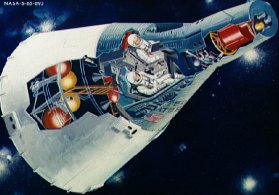

Before Gemini could get off the ground, the Russians, who were becoming masters of pulling the rug from under NASA's feet came up with another space first. Cosmonaut Leonov left his spaceship and high above the earth became the first human being to perform a spacewalk. To rub salt in the wound Pravda also announced that Voshkod was the first 3 man spacecraft and took great joy in pointing out that the Americans were still three years away from producing their 3 man Apollo capsule.
The headline said 'SORRY APOLLO'.
The truth was the Russians had managed to cram an extra cosmonaut into their two man craft in order to create another first.
 For the Gemini missions nine more astronauts were added to the original Mercury 7.
For the Gemini missions nine more astronauts were added to the original Mercury 7.
The missions started well. Gemini 3 proved how manoevrable the craft was. Gemini 4 included the first American spacewalk. Gemini 5 stretched the flight duration record to eight days and Gemini 7 increased it to fourteen.
Gemini 6 and 7 were the first spaceships to rendevouz in space, moving to within a few inches of each other.
The objective for Gemini 8 was to dock with an unmanned Agena spacecraft that had been put into orbit hours earlier. The mission was piloted by Neil Armstrong and Dave Scott and it would nearly cost them their lives.
The docking manoevre was a success but as the coupled ships flew high over China they began to spin out of control. There seemed to be a problem with the Agena spacecraft and as the spin rate climbed Armstrong was forced to undock from the unmanned spacecraft. This just increased the spin rate of the Gemini. One of the thrusters was stuck open and the Agena had actually been holding the two craft steady. Once uncoupled the Gemini started to spin wildly out of control. The astronauts were fast reaching the point where the would become unconscious and die. Armstrong hit the re-entry rockets and slowly the spin rate dropped. It took the astronauts another half an hour before they could bring their Gemini under control.
The ship was now low on fuel and Armstrong had to make an emergency re-entry out of range of the tracking stations that would guide them down to splashdown.
Armstrong's skill and coolness in an extreme emergency would not be forgotten when it came to flying the Apollo missions.
Gemini 9, 10 and 11 proved successful in knocking down the obstacles that stood between them and the moon....except one.
Spacewalking was still giving the astronauts extreme problems and if that nut couldn't be cracked then the moon landings were no-go.
It was only on the final Gemini mission that an astronaut was able to learn from all the experiences and problems from previous attempts and finally showed that it could be done. That astronaut was Buzz Aldrin.
Gemini consisted of 10 missions in 12 months and had put the American space program on course for the moon. It had also moved the Americans past the Russians who had achieved only one space walk and had yet to master manoevring a spacecraft in orbit.
Project Apollo would deliver the moon but there would be a heavy price to pay.

 Page 4 |
 Page 6 |
